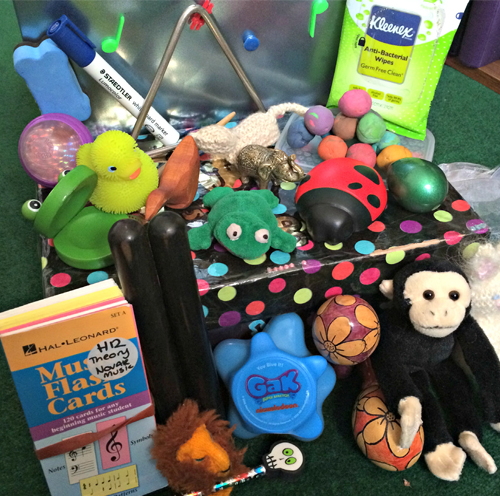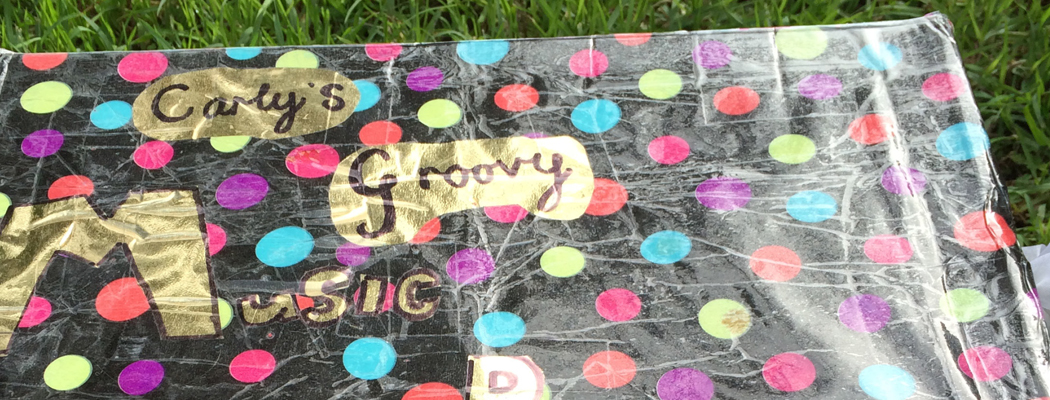I have a Groovy Music Box. It holds all sorts of wonderful things to use in lessons and is a great icebreaker for new students and those not having a good day. It is a hit with primary school aged children, but the group I use it the most with is the early learners.
It all began when my first early learner came to the studio. He was four, very bright and a little bit quirky. This was over a decade ago when there weren’t as many great resources around for the early beginners. So I set about making my own curriculum and this is how the music box was born. I found an old shoe box and covered it with bright wrapping paper and stickers. It was bright and just big enough for me to keep the resources for that particular lesson in.
One lesson we were exploring the musical alphabet, I thought I’d done really well to collect an item starting with each letter required. A for apple, B for banana, C for carrot, D for dragon fruit, E for egg and so on. He went into the box ready for his lesson. Imagine my surprise when I opened the box in the lesson and he screamed and hid behind his mum! Apparently he had a phobia of fruit and vegetables! Since then I have, through trial and error, found what works best in the music box. Resources that make it easy to use for a wide range of students and activities to have on hand for those ‘need a change of pace’ moments.
Firstly there are LOTS of animals. I have discovered, since the fruit incident, that animals are much safer! We have Ribbit the frog, who is an original member of the music box cast. He is great for jumping off the back of little hands up to the music stand to demonstrate staccato, and also helpful for sounds on the piano around middle C. Most recently he has featured for a young student doing a glissando, apparently it wouldn’t give him a headache but it would save her little fingers! Then we have Dorothy the duck, Fluffy Rabbit, Disco Tweet, Zor the elephant, Roary the lion, Wendy the whale, Daisy the ladybug, Neko the cat and Mr Mischief the monkey! Most of these animals are used when young students begin with ‘sound mapping’ the piano, gauging pitch-high/low and direction-up/down. Students can put the animals on the piano and experiment with creating sounds of that animal. It is also very useful to bring in the animals for storytelling of pieces the student is learning. Or a small animal can be used to highlight a particular note on the piano if a piece has a large leap in it, giving a visual cue for the new location.
Several animals have a further, techniquebased purpose. Recently Daisy the ladybug has come to our studio and each of my young students has one at home as well. Daisy is used as a physical prompt for developing hand posture. Held in the palm of the hand with the nose out towards the thumb, this demonstrates beautiful hand shape. This is a tip I picked up from Diane Hidy’s blog and is a winner for my students!

Mr Mischief the monkey is also helpful for students who have very stiff arms. Irina Gorin has some excellent YouTube teaching videos and in one uses a toy monkey to demonstrate the arm being a branch of a tree and the monkey on the branch going for a ride in the breeze. The imagery of this and the cue of having the monkey on their arm draws the student’s awareness to the body and opens a discussion about relaxation through the arms and shoulders. It’s also great fun and the kids love Mr Mischief!
Moving on from the animals, another original cast member is the modelling clay. It is great for practising terms and signs, and doing games. I pick a recently learnt sign for the student to make and they pick one for me to make. Normally they pick the hardest thing they can think of for me to make, which gives me some insight into the terms and signs I need to work with them on more in the future. Then we have a race to make them. It’s hands on, 3D and a great activity away from the piano. I would recommend this one at the end of the lesson as kids fingers sometimes need a clean if they pick at the clay!
Which brings me to my next item, hand wipes. These are young children we are dealing with, they bring all sorts of surprises with them. Having some antibacterial wipes in the music box is a must.
I have GAK in my music box. As a child of the 80s I love the GAK. I suppose the best definition of it is slime. It is great for getting the sensation of pushing through something into the student’s mind. Being able to feel the depth of their notes and being sensitive to the different depths they may use is the main purpose of having the GAK in the music box. It is also helpful to encourage firm rounded fingertips even when depressing the notes (rather than playing with straight fingers). The GAK stays in its container and it isn’t messy so it can be used at the piano.
For a bit of light relief I have a purple Honka in the box and a bouncy ball. The Honka is just like a clown horn. Sometimes when we are discussing different sounds it comes in handy, but it’s mostly there because it always gets a laugh or smile from a student who needs one. The bouncy ball is for my students who need physical play in their lessons. Away from the piano we can bounce the ball to one another (great for opening a discussion about accuracy). Alternatively we can bounce the ball high and watch how the first bounce is bigger and each subsequent bounce decreases in size. Much like a diminuendo!
Flash cards are also an original cast member! The cards that get used from the packs vary, sometimes we do rhythm activities with them, other times we find as many terms from their piece as we can in the pack. This encourages them to actively look at all of the terms and become familiar with them. Other times we can play ‘Hide and Seek’ with finding locations of notes on the piano with the note reading flashcards. Furthering this theory side of the music box and to encourage writing and drawing we have the small magnetic whiteboard, marker and magnetic music notes and rests. This is very versatile and can be useful for students who benefit from tactile, kinaesthetic learning opportunities.
Finally in the music box are a range of rhythm instruments. We have a triangle, a frog castanet, two sets of claves, an egg shaker that is just the right size for little hands and several shakers with small handles on them. There are a plethora of activities that these can be used for. From introducing each instrument to an early beginner, discovering what different sounds they can make with it, to learning rhythms in student pieces or mirrored rhythm activities, there are so many things you can do! Having them all at the ready means you never have to go looking during lesson time. Has a student got a piece that could benefit from an added triangle chime in a bar of rest? Why not bring it out? These instruments make opportunities for discovery of sound and enjoyment in their music and can all be integrated in piano lessons. Less so perhaps with my older students, but younger students eyes light up when they get to create with the music box.
There are some items that are transient in the music box, they come for some time and then cycle out. The items I have discussed here are those that have stood the test of time and durability! As for that first music box? They get a bit of wear and tear over the years and when it was time for the first to retire, that very first student asked if it could go and live at his house. I guess it made an impression and some lasting memories!
